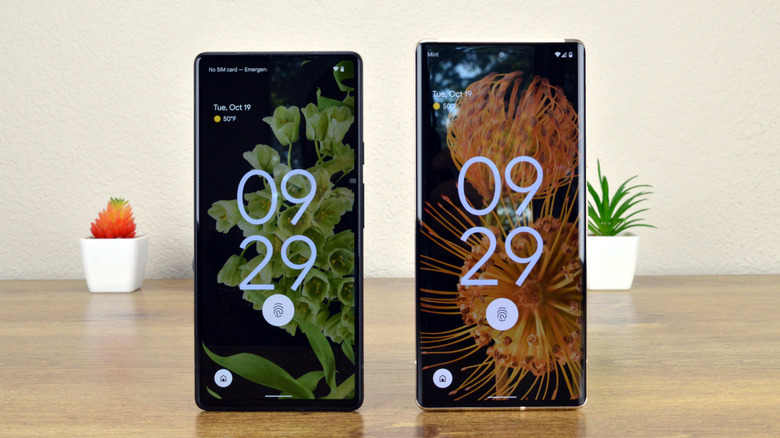Google Pixel 6 News: The Pixel 6 And Pixel 6 Pro Are Finally Here
Google took a different approach with the Google Pixel 5 in 2020. Instead of launching a flagship device, it included a midrange processor and lowered the price a little. While that made the Pixel series a little more accessible, it did leave some wanting a true flagship Pixel experience. That has finally arrived in the Pixel 6 and Pixel 6 Pro.
The new phones were heavily leaked and rumored before Google announced them, and a lot of what we knew came straight from Google itself. But not everything leaked. Here's everything you need to know about Google's exciting new phones.
Pixel 6 and 6 Pro design
Google Pixel 6 and 6 Pro
The Pixel 6 and 6 Pro look unlike any other phones that have come out so far. The devices swap out the square camera module on most flagship phones this year, in favor of a relatively large "camera bar" that extends across the back of the phones. It's large, but it allows the phones to sit on a table without moving around too much.
Both the Pixel 6 and 6 Pro are relatively large — in fact, the standard Pixel 6 is around as big as an iPhone 13 Pro Max. The extra height on the Pixel 6 Pro comes from the top of the phone. That's to say, the camera bar is the same distance from the bottom of the phone, and the top section is a little taller on the Pixel 6 Pro. The result is that the phones offer a slightly different aspect ratio. Around the edges of the phones, you'll get a USB-C port, volume rocker, and power button. Pretty much everything you would expect.
Google Pixel 6 and 6 Pro.
There are other differences between the phones too. The standard Pixel 6 has a flat display, while the Pixel 6 Pro has a slight curve around the edges. The Pixel 6 comes in Stormy Black, Kinda Coral, and Sorta Seafoam, while the Pixel 6 Pro comes in Stormy Black, Cloudy White, and Sorta Sunny.
Pixel 6 and 6 Pro display
The displays on the Google Pixel 6 and Pixel 6 Pro are pretty different. The standard Pixel 6 offers a 6.4-inch display with a 1,080p resolution and a 90Hz refresh rate, which can scale between 60Hz and 90Hz to save on battery. The Pixel 6 Pro steps things up to a 120Hz variable refresh rate, which can scale between 60Hz and 120Hz. It's not as variable as the iPhone 13 Pro, which can scale down to 10Hz, but it should still help cut down on battery use.
We're a little surprised that Google stuck with a 90Hz refresh rate on the standard Pixel 6, however, it seems to be one of the ways in which Google cut down on costs for the smaller phone.
Pixel 6 and 6 Pro specs
Google Pixel 6 and 6 Pro
Under the hood, the Google Pixel 6 and Pixel 6 Pro are unique. The phones are the first to feature Google's self-developed Tensor chip, which is an 8-core CPU. It's coupled with 8GB of RAM on the Pixel 6 and 12GB on the Pixel 6 Pro.
We'll have to wait and see just how well the phones perform against the competition from Qualcomm and Apple. Hopefully, they'll be able to hold their own.
When it comes to storage, both devices offer options for 128GB or 256GB, however, the Pixel 6 Pro also has a 512GB option for those who need the extra space.
The Pixel 6 and 6 Pro both support Qi wireless charging, along with fast charging at up to 30W with a compatible charger. Google says the phones should get "beyond 24-hour battery life," however we'll have to wait and see exactly how good the battery is.
Pixel 6 and 6 Pro camera
Google Pixel 6 Pro Camera
Then there's the camera, and at first glance, it looks exciting. Both phones have a 50-megapixel Quad Bayer wide camera and a 12-megapixel ultrawide camera with a 114-degree field-of-view. The Pixel 6 Pro, however, adds a 48-megapixel telephoto camera with 4x optical zoom, and support for up to 20x Super Res Zoom.
Perhaps more interesting than the specs are the camera features. Perhaps the most interesting of those is the new Magic Eraser feature, which can remove background objects from an image, including people. We'll have to wait and see just how well this feature performs in the real world. Other features include Face Unblur, which can make for a sharper image.
Pixel 6 and 6 Pro price and availability
The Pixel 6 and Pixel 6 Pro are now available for purchase from your preferred electronics retailer or carrier. They're available from all of the major carriers in the U.S., and you can get them straight from the Google store. The Pixel 6 comes at $599, while the Pixel 6 Pro starts at $899. That's not bad for what may end up being flagship-level phones.
Find out more about where to buy the Pixel 6 and Pixel 6 Pro here.
